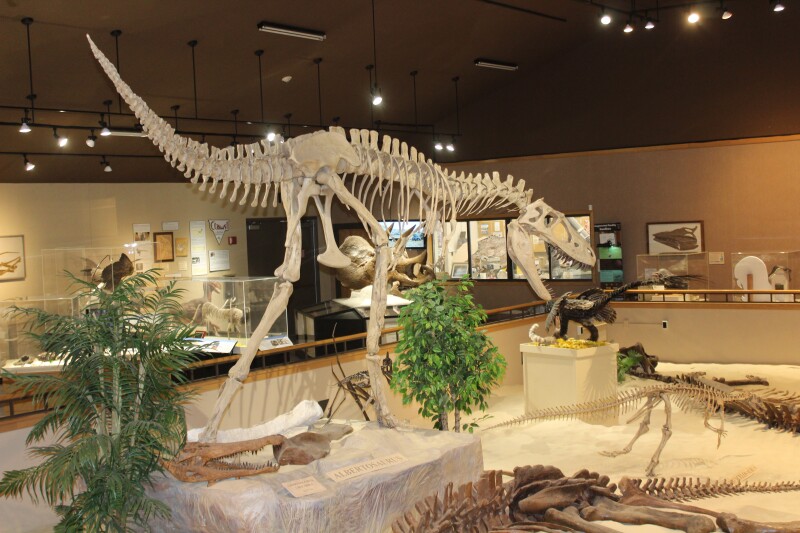Science
Badlands Dinosaur Museum Specimen Sparks Global Study on Mating Injuries

A specimen known as “Warwick’s Duck,” displayed at the Badlands Dinosaur Museum in Dickinson, North Dakota, has become a focal point in an international study examining mating injuries in “duckbilled” dinosaurs. The research, led by Filippo Bertozzo, Ph.D., investigates rear spinal injuries in hadrosaurs, a family of plant-eating dinosaurs recognized for their distinctive duck-bill shaped skulls.
The study draws from various hadrosaur specimens worldwide to analyze the causes of these injuries. It concludes that the rear spinal injuries may have resulted from mating activities, supported by detailed statistical analysis and computer simulations. A press release announcing the paper states, “Statistics and computer simulation of bone stress led the international team of paleontologists to suggest that the bone fractures were caused by the male crushing the backbones of the female during mating.”
Significance of Findings
Included as co-authors are Elizabeth Freedman-Fowler, dean of applied science at Dickinson State University, and her husband, Denver Fowler, curator of the Badlands Dinosaur Museum. They emphasized the potential implications of these findings in distinguishing between male and female dinosaurs. “All of the specimens that show this injury should be female, they should all show some of the features that we’re suggesting might be female,” said Fowler.
While the research offers a promising avenue for determining dinosaur sex, both scientists cautioned that further independent research is necessary. They noted that rear spinal injuries alone cannot definitively differentiate between male and female hadrosaurs.
In 2016, shortly after assuming his role at the Badlands Dinosaur Museum, Denver Fowler curated an exhibit featuring “Warwick’s Duck,” a hadrosaur fossil discovered by his father, Warwick Fowler. This specimen, on loan from the Museum of the Rockies in Bozeman, Montana, has drawn significant attention. “When my dad found this specimen in 2009, I thought straight away like this looks like these kinds of mating injuries,” Fowler remarked. “It was like the best one I’d ever seen.”
A Collaboration Across Continents
The exhibit caught the interest of Darren Tanke from the Royal Tyrrell Museum of Palaeontology in Drumheller, Alberta, Canada. Tanke had been cataloguing similar injuries in fossils for years. Freedman-Fowler joined the project shortly afterward, and the trio presented their findings on “Warwick’s Duck” at a paleontology conference in Dickinson in 2019. During this conference, Bertozzo, then a doctoral student in Ireland, expressed enthusiasm for the specimen.
Bertozzo has since examined similar fossils globally, including those from as far as Russia. His paper, which features contributions from scientists across several countries, including Russia, Italy, and the United Kingdom, was published on November 4, 2025, and is accessible through iScience, an open-source scientific journal.
Visitors can view “Warwick’s Duck” at the Badlands Dinosaur Museum. Additional information about the museum’s exhibits and operating hours is available on its official website and social media channels.
-

 World3 weeks ago
World3 weeks agoGlobal Air Forces Ranked by Annual Defense Budgets in 2025
-

 World3 weeks ago
World3 weeks agoMass Production of F-35 Fighter Jet Drives Down Costs
-

 Science3 weeks ago
Science3 weeks agoTime Crystals Revolutionize Quantum Computing Potential
-

 World3 weeks ago
World3 weeks agoElectrification Challenges Demand Advanced Multiphysics Modeling
-

 Top Stories3 weeks ago
Top Stories3 weeks agoDirecTV to Launch AI-Driven Ads with User Likenesses in 2026
-

 Top Stories3 weeks ago
Top Stories3 weeks agoNew ‘Star Trek: Voyager’ Game Demo Released, Players Test Limits
-

 Lifestyle3 weeks ago
Lifestyle3 weeks agoDiscover Reese Witherspoon’s Chic Dining Room Style for Under $25
-

 Entertainment3 weeks ago
Entertainment3 weeks agoFreeport Art Gallery Transforms Waste into Creative Masterpieces
-

 Health3 weeks ago
Health3 weeks agoGavin Newsom Critiques Trump’s Health and National Guard Plans
-

 Business3 weeks ago
Business3 weeks agoGold Investment Surge: Top Mutual Funds and ETF Alternatives
-

 Politics1 week ago
Politics1 week agoLanguage Evolution: New Words Spark Confusion in Communication
-

 Lifestyle3 weeks ago
Lifestyle3 weeks agoLia Thomas Honored with ‘Voice of Inspiration’ Award at Dodgers Event









